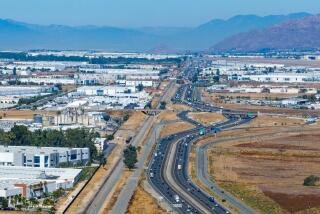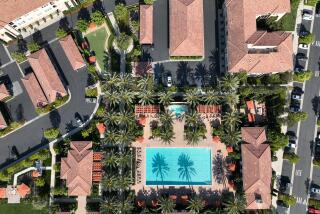Following a Money Trail Out of Simi
- Share via
SIMI VALLEY — Residents here throw themselves into local PTAs and homeowners associations. Their weekends are spent at neighborhood churches and soccer leagues. They sink hours into community projects such as Vision 2020 and the neighborhood councils.
What residents don’t do enough is shop locally.
That’s according to a study released Friday that found that the city of Simi Valley is “leaking” about $423 million in sales revenue to other cities each year.
Bluntly put, Simi Valley is outsold by the mighty Oaks mall and the chichi Promenade at Westlake in Thousand Oaks. Valuable retail dollars--and, thus, sales tax receipts--are siphoned away by the west San Fernando Valley’s endless parade of stores such as the Gap, Macy’s, Nordstrom, J. Crew, Pottery Barn and Brooks Brothers.
Other money seeps out of the city’s coffers due to the dearth of fancy restaurants and “big box” retailers offering furniture, appliances, electronics, toys, computers and sporting goods.
Not that Simi Valley residents can be faulted for shopping out of town. Their local retail options are limited.
If Fido needs food, there is Petco. The city boasts hardware shops aplenty, several car dealerships, a Vons or Ralphs in virtually every neighborhood and a big Target and K mart.
The shortage of clothing boutiques and department stores is this city’s retail rub, according to the survey by the Natelson Co. of Encino. The company’s analysis of retail sales leakage--which cost the city about $32,000--will be presented at the City Council meeting Monday night.
“Too many of our residents have to leave the valley to purchase things you can’t find here,” fumed City Councilman Paul Miller on Friday. “If I want to buy a brand-new men’s suit, I have to go somewhere else. You can’t buy a men’s suit here. In a town of 100,000 people, that’s ridiculous.”
Based on the sheer numbers and wealth of people who live in Simi Valley and in nearby Moorpark and Fillmore, this city should be able to pull down about $1.13 billion in sales revenue annually, according to the study. Instead, the city receives about $700 million, as shoppers are forced to go elsewhere for some goods.
And the city loses millions in tax dollars a year.
Sales taxes are expected to account for $8.8 million of the city’s general fund in the current fiscal year. They are the single largest source of cash for the city’s $35.9-million budget.
“A strong sales-tax base is vital to maintaining a strong fiscal position,” said Assistant City Manager Don Penman. “Obviously, the more sales tax you have, the more flexible your [city] budget is. Thousand Oaks, for example, has about twice the sales tax receipts we have, in a city of comparable size.”
Not coincidentally, Thousand Oaks has a showcase public library and massive Civic Arts Plaza--perks Simi Valley lacks.
If Simi Valley were to retain the substantial sales lost to other, better-stocked cities, it needs an additional 2.3 million square feet of retail space, the study found.
This fact will be used as a selling point in Simi Valley’s ongoing efforts to woo department stores, a regional mall, “big box” retailers and restaurants, Penman said. The city has been working for a decade to open its own regional mall on 120 acres at the Ronald Reagan Freeway and 1st Street.
“What this study shows is, within our area, there are a lot of opportunities for someone to come in here and open an enterprise that could make them some money,” Councilman Miller said. “It shows we could support a regional mall. No question about it.”
The city’s last formal tax leakage study took place 11 years ago and yielded similar statistics. While Simi Valley’s total retail sales have increased by 133% since the last study, the population and its spending power have grown in tandem.
More to Read
Inside the business of entertainment
The Wide Shot brings you news, analysis and insights on everything from streaming wars to production — and what it all means for the future.
You may occasionally receive promotional content from the Los Angeles Times.










